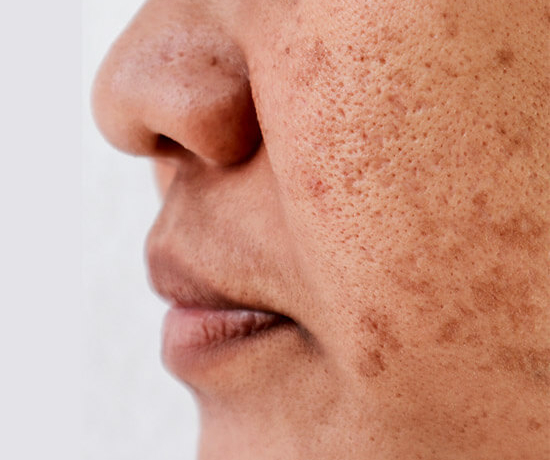Pigmentation is a complex process that determines the colour of our skin, hair, and eyes. It is controlled by specialised cells known as melanocytes, which are located in the basal layer of the skin’s epidermis. These cells produce a pigment called melanin, which is responsible for giving our skin its unique shade.
As we move out of summer, you may find many of your clients showing signs of hyper-pigmentation. Keep reading to learn more about the leading causes of hyper-pigmentation and how best to treat it internally
What causes hyper-pigmentation?
Pigmentation is a skin concern that arises due to an imbalance in the complex process of melanin production. While melanin production is normal for our unique skin, eye and hair colouring, when melanocytes become damaged, they can become overactive and start producing excessive melanin, leading to patchy pigmentation, also known as hyperpigmentation. In essence, “hyper” means more, and “pigment” means colour. Hyperpigmentation is often described as age spots, sunspots, brown spots, uneven skin tone, and discolouration.
There are a few known factors that can result in the overproduction of melanin, including:
Sun Exposure
When our skin is exposed to UV rays and blue light, it stimulates melanocytes to produce melanin. Melanin acts as a natural shield against UV radiation; it absorbs and disperses the rays to protect our skin cells from damage. However, overexposure to the sun can disrupt the normal production and distribution of melanin in certain areas, leading to the formation of patches of darker skin. [1]
Oxidative Stress
Oxidative stress is an imbalance between free radicals and antioxidants in your body. This can be caused by various lifestyle factors such as smoking, poor diet, and overexposure to the sun. Free radicals are known as oxygen-derived molecules with unpaired electrons – this makes them highly reactive and susceptible to damage [2]. They can stimulate the activation of melanocytes [3], leading to increased melanin production. Melanocytes respond to oxidative stress by producing more melanin as a defence mechanism. When melanocytes are overstimulated, excessive melanin production can result in hyperpigmentation, such as sunspots, brown spots, and age spots.
Hormones
Melasma, a type of hyperpigmentation, can occur due to hormone imbalances such as pregnancy or starting the contraceptive pill. During pregnancy, this is known as “the pregnancy mask”, as the pigmentation commonly affects the cheeks, nose, chin, upper lips and forehead.
Post-Inflammatory Pigmentation (PIH)
This is when the skin experiences trauma from squeezing or picking spots; it triggers an inflammatory response that can disrupt the normal functioning of melanocytes. This disruption can lead to abnormal melanin production and deposition, resulting in skin discolouration. This condition is known as Post-Inflammatory Hyperpigmentation (PIH) and can take a significant amount of time to naturally fade. It is more common in darker skin types [4].
Age & Genetics
Hyperpigmentation is a common symptom that accompanies ageing skin, which is caused by a combination of age and genetics [5]. As we grow older, our skin undergoes both chronological ageing and environmental ageing. Chronological ageing is dependent on the passage of time, whereas environmental ageing caused by external factors such as sun exposure and air pollution. With age, our cells’ function and integrity become more compromised, which can result in abnormalities in melanin production [6].
To support and manage this skin concern, our researchers recommend taking:
Skin Ultimate: Each daily pod features five clever capsules: Skin Omegas+, Skin Vit A+, Skin Asta-Boost, Skin Co-Q10+ and Skin Antioxidant to deliver award-winning, skin-enhancing results.
Skin Vit C: Zinc, vitamin C and acerola cherry to brighten the complexion.
It’s also essential to wear an SPF daily to protect your skin from blue light and UV rays to ensure you are achieving 100% skincare by protecting the skin from the inside and out.
Sources:
[1] The Protective Role of Melanin Against UV Damage, Michaela Brenner, National Library of Medicine, 2007
[2]The Science of Dark Spots, The International Dermal Institute, March 22, 2021
[3]Melanocytes as Instigators and Victims of Oxidative Stress, L. Denat, National Library of Medicine, 2014
[4]The Science of Dark Spots, The International Dermal Institute, March 22, 2021
[5] Skin Pigmentation Abnormalities and their possible relationship with ageing, National Library of Medicine, Ai-Young Lee, April 2021
[6] Skin Pigmentation Abnormalities and their possible relationship with ageing, National Library of Medicine, Ai-Young Lee, April 2021
Image source: Canva


